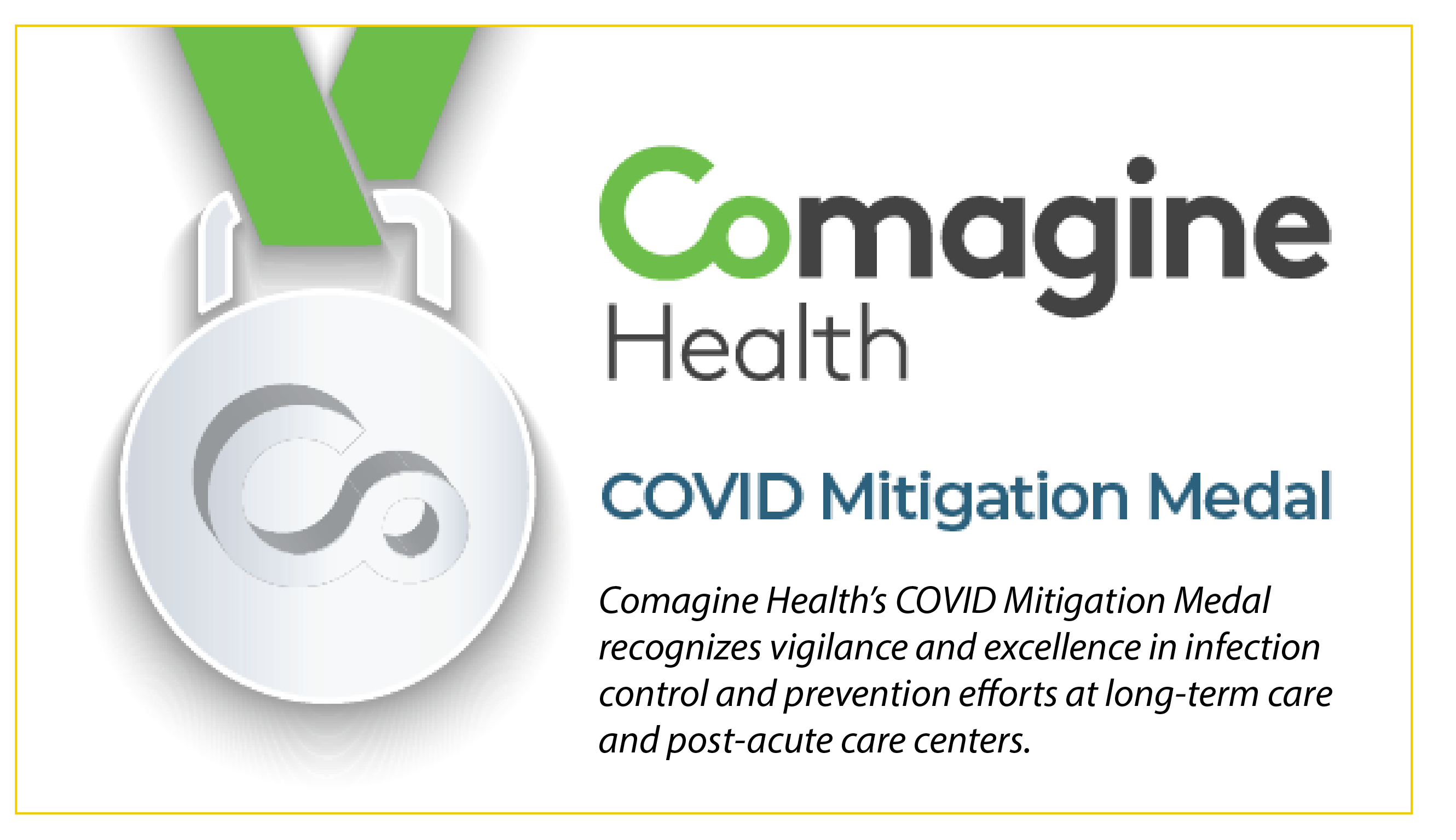An urban nursing home in the Pacific Northwest was referred by the Centers for Medicare & Medicaid Services (CMS) to Comagine Health, a CMS Quality Innovation Network-Quality Improvement Organization (QIN-QIO) for assistance with improving its resident COVID-19 bivalent booster rate. By implementing the interventions recommended by Comagine Health, the nursing home increased its resident COVID-19 bivalent booster rate by 53.9 percent from the time the facility was referred to the QIN-QIO and the last report to the National Healthcare Safety Network in January 2023.
Combatting Vaccine Hesitancy with Tailored Resources
Following an initial conversation with the nursing home, Comagine Health conducted a root-cause analysis that revealed vaccine hesitancy as the reason for the facility’s low resident COVID-19 bivalent booster rate. This hesitancy was the result of a highly educated, computer-literate population that is distrustful of the government. To address these concerns, Comagine identified resources that support the safety and efficacy of the vaccine from non-governmental sources, such as medical schools and AARP.
Teaching Motivational Interviewing Using a Two-Part Strategy
Comagine Health also taught nursing home staff about motivational interviewing using a two-part strategy. The QIN-QIO provided a conversation guide that explains how to integrate staff into conversations with residents about vaccination. For example, instead of having the same certified nursing assistants speak with residents about getting vaccinated, the guide encourages facilities to involve floor nurses, front desk staff or activity staff in these conversations. The guide also explains how leadership should talk to their staff about having these conversations with residents.
The second part of the strategy encouraged nursing home staff to practice the presumptive approach to vaccination using the SHARE model. This approach assumes that a resident will want to be vaccinated and in practice includes:
- Sharing the reasons why the booster is right for the resident
- Highlighting personal positive experiences with the booster to reinforce the benefits
- Addressing resident questions and concerns about the booster
- Reminding residents that COVID-19 vaccines help protect them and their loved ones
- Explaining the potential costs of getting COVID-19 such as health effects for the resident or spreading COVID-19 to other residents
The Comagine Health team, which recently received training on the presumptive approach from Dr. Sabine von Preyss-Friedman, MD, FACP, CMD at AMDA, the Society for Post-Acute and Long-Term Care Medicine, also explained that this approach requires empathy and understanding to get to the root cause of the resident’s hesitancy.
Additional information about motivational interviewing provided to the facility included resources from the National Library of Medicine and the Centers for Disease Control and Prevention.
Driving Improvement through Recognition
 To motivate all referred nursing homes to increase their resident COVID-19 bivalent booster rates, Comagine Health created a COVID-19 Mitigation Medal award program. Facilities that have an up-to-date rate of 80 percent or more receive the award along with a press package, their name featured in a winner’s announcement and a website badge for promotion. In the fourth quarter of 2022, 16 nursing homes in Comagine Health’s four-state region received the award.
To motivate all referred nursing homes to increase their resident COVID-19 bivalent booster rates, Comagine Health created a COVID-19 Mitigation Medal award program. Facilities that have an up-to-date rate of 80 percent or more receive the award along with a press package, their name featured in a winner’s announcement and a website badge for promotion. In the fourth quarter of 2022, 16 nursing homes in Comagine Health’s four-state region received the award.
For facilities that are close to the up-to-date rate (like the nursing home featured here), Comagine Health reaches out to help the nursing home set small goals to reach the overall goal of 80 percent. For example, Comagine might suggest a nursing home aim to vaccinate one or two residents each week versus trying to increase their rate by a specific percentage. In a follow-up conversation, Comagine can perform a root-cause analysis if the small goal was not met and work with the facility to develop a solution.
Supporting All Nursing Homes’ Vaccination Efforts
To supplement Comagine Health’s one-on-one assistance, the QIN-QIO also offered several additional resources and strategies to support this and other nursing homes in its region. These included:
- A monthly Vaccination Station office hours series focusing on different vaccination-related issues. The series is intended to help all nursing homes find new tools to use in their vaccination toolbox. Topics include motivational interviewing, use of therapeutics and involving resident council members in vaccination decisions. On average, five to 10 nursing homes participate in this series.
- Driving Clinical Excellence e-blast sent every other week to facilities following their referral to Comagine Health. The blast includes resources tailored to vaccination as well as other clinical quality measures. More than 600 nursing homes and 1,300 individuals receive this publication.
- Comagine Health Digital Newsletter sent weekly to all nursing homes. It includes one to two articles of interest on a variety of topics, information about vaccinations and information about upcoming CMS calls, memos and guidance. More than 6,000 people receive this weekly publication which has a 15-20 percent average open rate and a 20-25 percent average click-through rate.
- An NHSN guide for facilities that may have reporting errors. The guide includes steps for addressing common NHSN errors and Comagine Health’s NHSN expert is available via email to answer questions. The QIN-QIO also hosts NHSN open office hours during which the expert reviews any NHSN updates and answers questions from nursing homes. On average 10-20 nursing homes participate in these sessions.
Keys to Success
Comagine Health’s success helping the nursing home increase its resident COVID-19 bivalent booster rate by nearly 54 percent can be replicated by taking the following steps:
1) Tailor tools and resources to facilities’ unique populations
2) Focus on small goals
3) Offer a motivator
All nursing homes in the region served by Comagine Health that were referred to the QIN-QIO for assistance between October 16, 2022 and January 1, 2023 saw a 10.8 percent net increase in resident COVID-19 bivalent booster rates as compared to nursing homes in the state that were not referred to the QIN-QIO for assistance. In addition, the percentage of residents who are up to date in nursing homes in the region that were referred to the QIN-QIO for assistance, increased by 27 percent, compared to residents who are up to date in nursing homes not referred to the QIN-QIO, which increased by only three percent.
Comagine Health’s Regional Nursing Home Resident COVID-19 Vaccination/Booster Rates Including Referrals from October 16, 2022 through January 1, 2023.
The graph compares bivalent vaccination rates of CMS-referred facilities (orange) with never-referred facilities (blue) and only includes referrals made between October 16, 2022 and January 1, 2023. Never-referred facilities did not meet initial criteria for booster referral because CMS focused on facilities with significantly lower rates.

This material was prepared by The Bizzell Group (Bizzell), the Data Validation and Administrative (DVA) contractor, under contract with the Centers for Medicare & Medicaid Services (CMS), an agency of the U.S. Department of Health and Human Services (HHS). Views expressed in this material do not necessarily reflect the official views or policy of CMS or HHS, and any reference to a specific product or entity herein does not constitute endorsement of that product or entity by CMS or HHS. 12SOW/Bizzell/DVA-1142-07/18/2023

